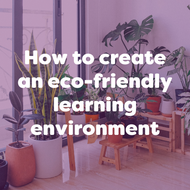How to create an eco-friendly classroom
Posted by EYR Team on 21st Aug 2023
read more
Creating an eco-friendly learning environment is an important step towards a sustainable future. Not only does it promote environmental awareness and conservation among students, but it can also save schools money on energy and resources. In this blog post, we'll discuss a few practical ways that teachers, childminders, and parents can create an eco-friendly classroom and environment.
What does eco-friendly mean?
Eco-friendly refers to products or practices that are considered to have a minimal impact on the environment. This can include items made from sustainable materials, such as recycled plastic or organic cotton, as well as activities that aim to reduce carbon emissions and preserve natural resources. Some common examples of eco-friendly practices include using energy-efficient appliances, conserving water, recycling, and supporting conservation efforts. The goal of being eco-friendly is to reduce the negative impact that human activity has on the planet, in order to promote a more sustainable future for all.
What are the benefits of creating an eco-friendly classroom?
Creating an eco-friendly learning classroom for children can have many benefits. By providing children with opportunities to learn about environmental issues and participate in eco-friendly activities, they can learn to make informed and responsible decisions about how to live in harmony with the planet.
Incorporating natural light, plants, and fresh air into the classroom can help improve air quality and reduce stress levels. Additionally, encouraging physical activity and outdoor play can promote physical fitness and mental health.
Eco-friendly learning environments can also promote critical thinking and problem-solving skills by giving children opportunities to learn about sustainable solutions and make positive changes in their own environment. It is a great way to show them the simple steps they can do in their daily lives to help reduce their environmental footprint.
In summary, an eco-friendly classroom can provide children with a sense of connection to the natural world and empower them to make a positive impact on the planet, while also promoting their health, well-being, and cognitive development.
5 easy ways to create an eco-friendly classroom
1. Start a garden
Starting a garden at school can be an excellent way to create an eco-friendly learning environment for students. Not only does it provide an opportunity for students to learn about the natural world, but it can also promote a sense of responsibility for the environment.
A school garden can also be a great way to promote community engagement and teamwork. Students, teachers, and families can work together to plant, maintain, and harvest the garden, and it can be a great way to bring people together and foster a sense of community pride and ownership.
In addition, having a school garden can promote healthy eating habits, as students can learn about the benefits of eating fresh fruits and vegetables, and even have the opportunity to taste and harvest the produce themselves. Furthermore, it can be used as an opportunity to teach about food and farming systems, sustainability, and the importance of being conscious of the impact of our food choices.
If you don't have a big outdoor space, this is no problem, see our suggestions below on point 4!
2. Set up a Green Team/Eco-Club
For young children, an eco club can provide a fun and interactive way to learn about the natural world and its impact on it.
Eco-club activities can be designed to be age-appropriate and hands-on, such as planting a school garden, recycling projects, or learning about composting. These activities can be used as a tool to support the curriculum and provide children with a sense of connection to nature, and help them to understand the importance of taking care of the environment.
Eco-club can provide young children with a fun and interactive way to learn about the natural world, develop important skills and foster a sense of responsibility towards the environment.
3. Start a recycling challenge
Challenge your class to a recycling game! This is a fun and interactive way to learn about a variety of materials if they can be recycled, and how we can recycle our own rubbish at home. All you need is the following:
- 4 containers
- Signs for "Paper", "Plastic", "Compost" and "Glass"
- Team charts
Divide your class into teams, or even challenge another classroom to a recycling contest. Who can recycle the most in a week? Award the winner with a certificate!
This is a great way to start conversations about looking after our planet, and help students develop an understanding for recycling.
4. Bring the outdoors inside
Bringing the outdoors into a classroom is a great idea because it can help students to be more engaged in their work. It also helps them to learn about things like plants, animals and nature. You could use natural materials in your lessons. If you're teaching about plants, bring in some live plants for the students to see up close.
If your setting is struggling for outdoor space then introducing an indoor garden is a great alternative. Children will reap the same benefits as an outdoor garden in terms of responsibility and understanding of the world.
5. Communicate sustainable efforts with parents and guardians
Communication with parents is important because it allows the teacher to stay in contact with them and also gives them a chance to share their concerns. Communication also helps maintain trust between parents and teachers, which will lead to a better relationship.
Communicating sustainable efforts with parents as a teacher is important for the success of both the school and the students. A lot of schools are making efforts to be more environmentally friendly, but if they don't communicate this with their parents it can lead to some confusion.
Try starting a newsletter to share your green initiatives, or have an open-door policy and allow parents to come in anytime they need help or if they just want to chat.
Final Tips
The first step to creating an eco-friendly classroom is to start a discussion. Having an open conversation about the environment in your setting means that you are already on the right track towards an eco-friendly environment regardless of your budget, resources or size of the setting.
On top of this and our 5 suggestions above - we recommend weaving in upcycled or repurposed items where you can in your setting. This could be using upcycled resources such as tyres for outdoor seating, utilising non-recyclable plastics in crafts or displays or even using materials such as bottles and cans for storage for art and craft supplies.
Any and all changes you make in your setting will have an impact on your little ones and slowly but surely you be able to make your space more eco-friendly!
We would love to hear your tips on how you make your setting that little bit more eco-friendly. Share them with our community over on social media by tagging us in your posts and stories or using the hashtag #ExploreWithEYR. We will repost anything we receive and together we can share ideas!









